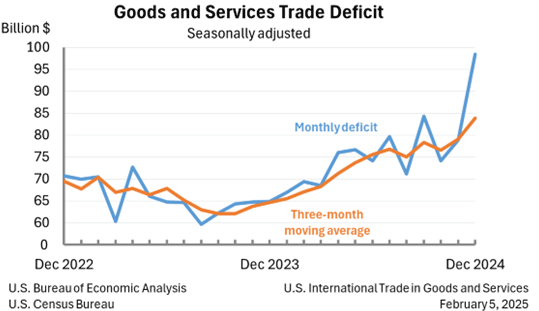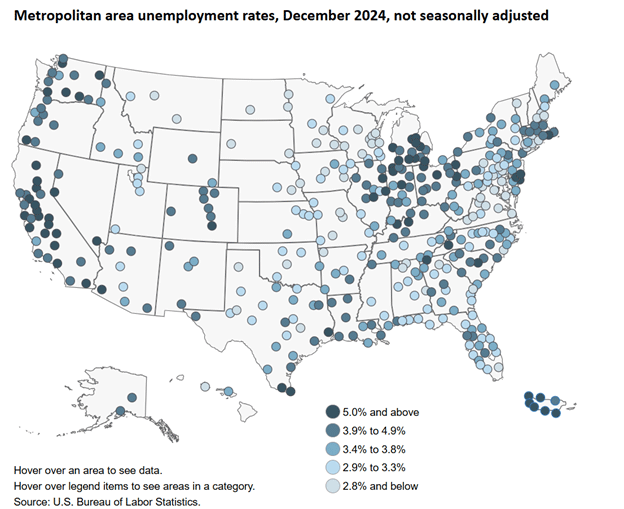EBRC Research Staff
Current data releases as of 14 February 2025
The December goods and services trade deficit came in at $98.4 billion, up $19.5 billion from a revised $78.9 billion in November. December exports fell $7.1 billion from November to $266.5 billion, and imports rose $12.4 billion to $364.9 billion. The increase in the deficit reflects an increase in the goods deficit of $18.9 billion to $123.0 billion and a decrease in the services surplus of $0.6 billion to $24.5 billion. For 2024, the goods and services deficit increased 17.0%, or $133.5 billion, from 2023. Exports in 2024 were $3,191.6 billion, up $119.8 billion from 2023, and imports were $4,110.0 billion, up $253.3 billion from 2023. The Netherlands ($55.5), South and Central America ($47.3), and Hong Kong ($21.9) show the greatest surpluses in 2024, while China ($295.4), the European Union ($235.6), and Mexico ($171.8) have the greatest deficits (in billions). -Delaney O’Kray-Murphy

Unemployment rates were higher in December for 68.3% of the 389 U.S. metropolitan areas. Eighty-five metropolitan areas posted unemployment rates less than 3.0%, and eight areas had unemployment rates of at least 8.0%. Before seasonal adjustment, Rapid City, South Dakota had the lowest unemployment rate at 1.8% while El Centro, California had the highest at 17.8%. The Phoenix MSA rate was 3.1%. Tucson was at 3.4%. Prescott posted the lowest rate in the state in December at 3.0% and Yuma had the highest at 11.9%.-George Hammond

Nonfarm payroll jobs rose over the year in 36 metropolitan areas and were essentially unchanged in 353 areas. The largest over-the-year increase was in New York-Newark-Jersey City with an increase of 136,500. The largest percentage gain was in Rochester, Minnesota at 6.8%. Over the year, the Phoenix MSA added 33,500 jobs in December. Tucson added 4,000. The Prescott MSA added 700. -George Hammond
U.S. payroll employment rose by 143,000 seasonally adjusted jobs in January 2025, down from a gain of 307,000 the prior month. That translated into 1.4% growth over the year (not seasonally adjusted). Over-the-month gains were strongest in private education and health services; retail trade; government; and other services. Jobs were down in professional and business services; mining and logging; and leisure and hospitality. With the January release, U.S. payroll employment estimates were revised (at least) back to April 2023 for non-seasonally adjusted data and back to January 2020 for seasonally adjusted data. The revisions reduced employment in 2024, with the annual average growth rate revised from 1.6% in the preliminary estimates to 1.3% in the current data. The U.S. unemployment rate ticked down to 4.0% in January from 4.1% in December. -George Hammond
The U.S. consumer price index for all items rose 0.5% over the month in January. Over the past twelve months, the all-items index was up 3.0%, a slight acceleration from December. The all-items less food and energy index was up 3.3%. Food inflation was 2.5% over the year, with a major assist from egg prices (up 53.0%). Shelter inflation hit 4.4% in January, the slowest pace since January 2022. Motor vehicle insurance inflation was rapid at 11.8%. With this release, the BLS has revised seasonally adjusted indexes for the previous five years to reflect new seasonal factors. -George Hammond
Use your cursor as a tooltip and click titles on/off in the legend at the bottom of the chart to make comparisons.
The U.S. producer price index for final demand rose 0.4% in January which translated into 3.5% growth over the year. Services prices rose 0.3% over the month and 4.1% over the year. Over one-third of the January monthly rise in producer services prices was attributable to traveler accommodation services. Final demand goods prices rose 0.6% over the month and 2.3% over the year. Over half of the January monthly increase was attributable to final demand energy. Prices for intermediate processed goods rose 1.0% in January, the largest increase since February 2024. Prices for unprocessed goods rose 5.5% in January, the fastest pace since May 2022. That reflected rapid increases in energy materials. -George Hammond
The December 2024 release of the Job Openings and Labor Turnover (JOLTS) report stated that the number of job openings in the U.S. fell to 7.6 million, with a job openings rate of 4.5% for the month. Arts, entertainment, and recreation experienced the largest increase in openings, adding 65,000 jobs, while professional and business services saw the largest decline, with a decrease of 225,000 positions. Nationally, the number of hires was 5.5 million, with a rate of 3.4% for December, the third consecutive month. The number of total separations in the nation was little changed at 5.3 million, with a rate of 3.3%. The number of quits was little changed at 3.2 million, with a rate of 2.0%. The number of layoffs and discharges changed little at 1.8 million and a rate of 1.1%. -Alex Jaeger





